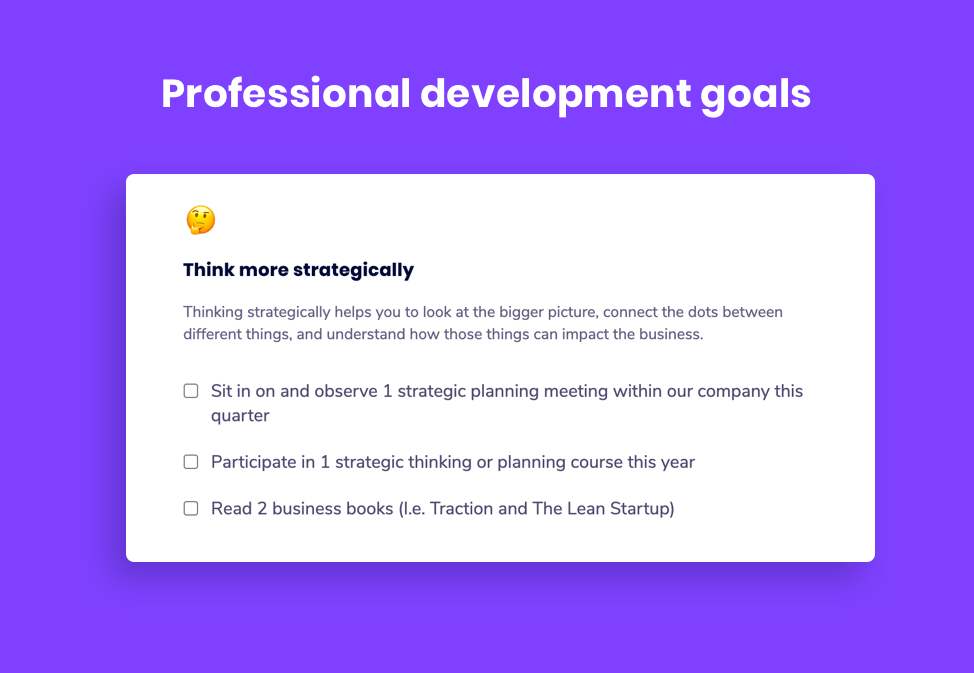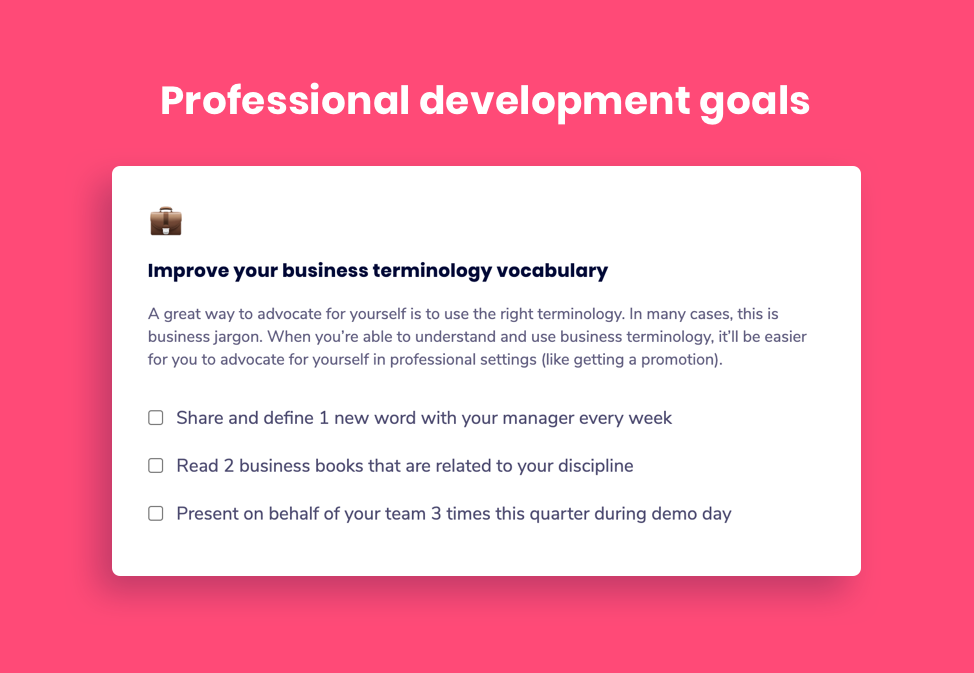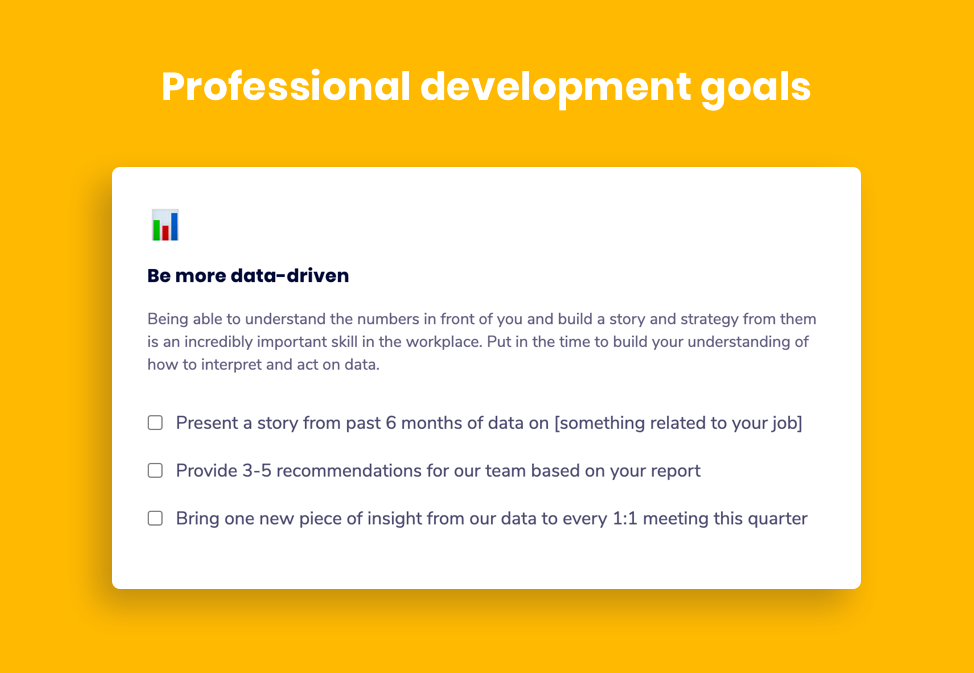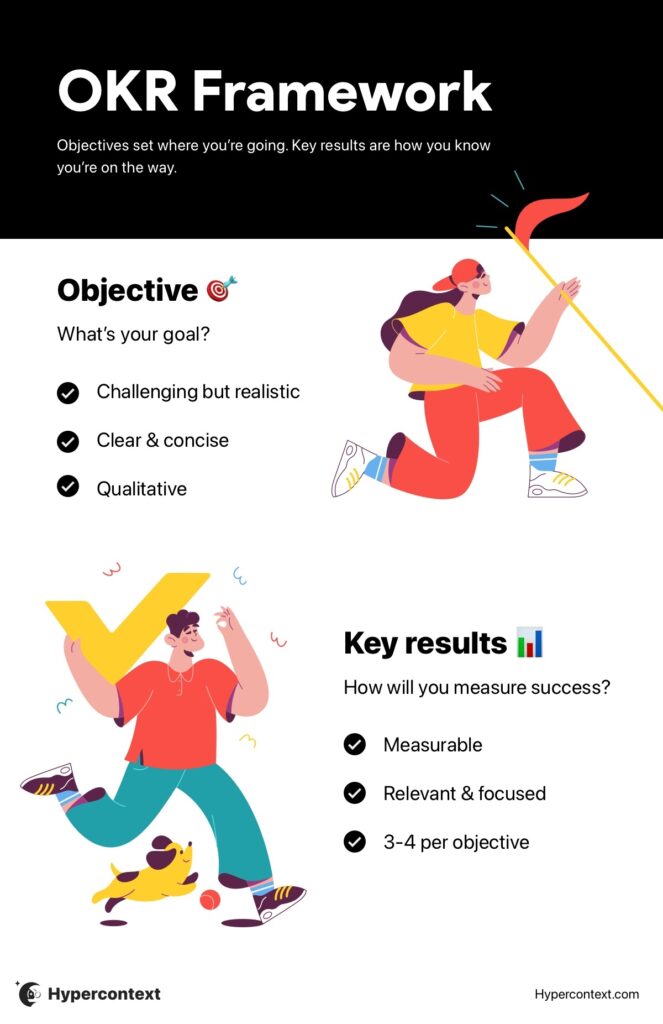The OKR meeting agenda for setting goals with your direct reports
In this article, we review how to run a one-on-one meeting dedicated to setting OKRs that help you and your direct report prepare, strategize and prioritize goals for the quarter.
 Alex Kinsella
Alex Kinsella
Warning: Undefined array key "category" in /www/hypercontext_216/public/wp-content/themes/Soapbox/hype-files/sections/article/content.php on line 10
When we think about goal setting, we think about the OKR framework.
It’s one of our favorite goal-setting frameworks because it helps create clear alignment across an entire company. The framework enables employees to help shape actionable and measurable goals, and see the impact of their work on the company at large.
What are OKRs, exactly?
OKRs are used to take big goals and break them into objectives (where we want to go) and key results (how we’re going to track our success).
We talk a lot about OKRs on a company-wide and team level — but what about OKR setting for individual employees?
Individual OKRs are an important part of your team’s growth and development.
So once you develop your OKRs as a team, check in with employees one-on-one to plan, set and track their individual goals. Whether you choose to incorporate goal-setting into your already scheduled one-on-ones or have a separate meeting quarterly to focus on goals, don’t neglect one-on-ones as part of the goal-setting process.
In this article, we’re going to walk you through what you need to add to your OKR meeting agenda for setting goals one-on-one, including:
- Why it’s important to set individual OKRs
- How managers can help their team members set OKRs
- What to add to your OKR meeting
- OKR goal-setting one-on-one meeting template
Why it’s important to set individual OKRs
There’s a healthy debate on whether individual OKRs help or hinder employees. To work, you need to understand how individual objectives feed into the team and organizational ones. They can’t work in isolation.
Setting and tracking individual OKRs helps your employees (and your business) through:
- Independence: individual OKRs aren’t a task or to-do list. They give your employees a clear understanding of where to go, but the freedom to make their own way there.
- Engagement: mission statements on a plaque are so 2000s. Individual OKRs tied to bigger picture goals show your employees the real-world impact of their effort.
- Growth: OKRs that work are designed to be challenging. Setting individual OKRs can help with professional development goals, including setting goals for advancing inside your organization.
How managers can help their team members set OKRs
When employee set their individual goals in a silo, they miss an important piece of the puzzle: alignment. As a manager, part of your job is helping team members create goals that align with team OKRs.
Individual objectives shouldn’t be “Get great feedback at my next quarterly performance review.”
Instead, they should ladder up to the goals of your team at large.
Here’s an example:
Let’s say you’re the manager of a customer success team with an objective to “deliver a best-in-class customer service experience.” Your team gets together and decides on 3 key results that are actionable and, most importantly — measurable:
- Close 75% of tier two tickets within one business day
- Reduce the number of escalated tickets by 50%
- Earn an average 4-star rating on closed tickets
This is where the magic of OKRs kicks in. Your employees work together to set the team OKRs. Now they can work with you individually to develop their own OKRs that move the needle forward on the team and organizational objectives, as well as their personal growth. Win-win!
Here’s an example of an individual OKR that can help drive progress towards this team objective.
Objective: Deliver an exceptional tier one support experience
Key results:
1. Reduce the number of escalated tickets by 50%
2. Reduce average chat/call time by 4 minutes
3. Get five positive reviews from customers
At first look, these key results might seem prescriptive. But they’re the box that gives your employee the freedom to think outside of. Knowing how to measure their progress gives them the opportunities to find innovative solutions. In this case, your employee could take the initiative to create a new internal knowledge base or wiki to help find answers faster. This benefits them, their teammates, and your organization — and gives your employee a sense of ownership and accountability in your company’s long-term success.
Here are some more examples of what individual OKRs could look like:



What to add to your OKR meeting
Here are 5 questions you can add to your 1:1s at the beginning of each quarter to help your direct reports create and track progress on OKRs.
1. How did our OKRs perform last quarter?
If you’re in the gym and easily doing 20 reps of the same weight, you know that it’s time to add a plate on the bar. The same goes for OKRs.
Reviewing last quarter’s OKRs gives you and your employee an understanding of what worked, what didn’t and where you can challenge yourself more in the quarter ahead. Some things to focus on in this discussion include:
- Where did we succeed?
- Where did we fall short?
- What did we learn?
Remember: Writing great OKRs means setting goals that are challenging. That also means that you shouldn’t get discouraged if you don’t reach 100% of every key result. Many companies using the OKR framework celebrate 70% as a job well done.
What are 3-5 goals you want to accomplish in the next quarter?
Once you’ve reviewed what worked and didn’t work last quarter, it’s time to start setting your goals for the upcoming few months.
At the time of this meeting, you should already know your team’s OKRs. Now’s the opportunity to dive deeper into what your individual direct report wants to accomplish. From there, find the overlap between their unique aspirations and your team’s goals.
The objectives you set together could be professional development, upskilling, or even looking for an opportunity to develop a new skill to make a career change.
Pro tip: If you’re looking for some inspiration, we’ve got a free library filled with over 270 OKR examples to help you jumpstart your goal-setting.
What key things need to happen to achieve those 3-5 goals?
Once you have the goals set, it’s time to define how you’ll track the progress. AKA your key results. It’s best practice to keep key results measurable and also to a minimum. If you start listing too many, you start to lose focus.
Remember that key results and activities aren’t the same things. Key results are more focused on the outcomes than output, which, as Brennan explains in the video below, are especially important when managing remote teams with trust.
What resources, tools, and budget do you need to achieve your goals?
Creating but not tracking progress is the cardinal sin of OKRs. A close second is not providing your team with the resources they need to achieve their goals.
During your OKR goal-setting 1:1, make sure to document the tools, budget, and other resources required for your team members to do their best work. Set your team up for success.
What could happen in the upcoming quarter that would prevent you from hitting your goals?
Some roadblocks you see a mile away, others sneak up on you. Your OKR meeting can help identify problems that could potentially prevent your employee from reaching their goals.
Your employee brings a “boots on the ground” perspective, while you bring a high-level view and context— both of which can help move boulders before they become a problem.
To help keep tabs on these potential roadblocks throughout the quarter, try implementing a traffic light system:
✅ Green= On track to hit goal
⚠️ Yellow= Unsure
🔴 Red= Not confident
This OKR management system allows you to quickly review progress towards OKRs at each one-on-one.
OKR goal-setting 1:1 meeting agenda template
Check out our OKR meeting agenda template for setting goals one-on-one.👇

What to do now
You made it to the end of this article! Here are some things you can do now:
- Our Goal & OKR examples are split by role, so you can find the perfect one for your team.
- You should try Spinach to see how it can help you run a high performing org.
- If you found this article helpful, please share it with others on Linkedin or X (Twitter)

